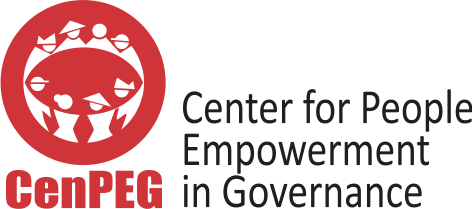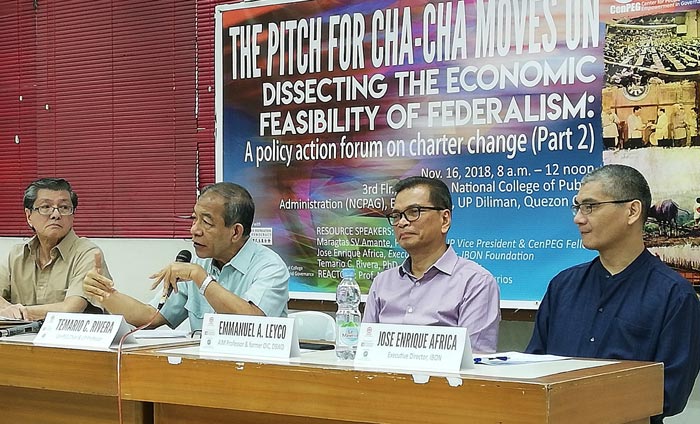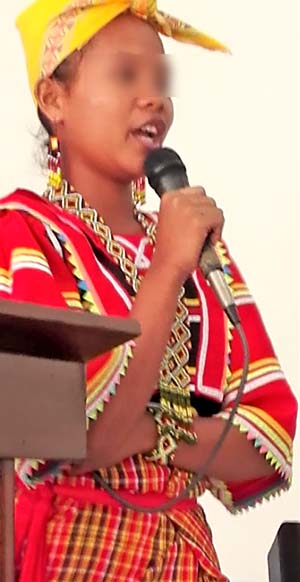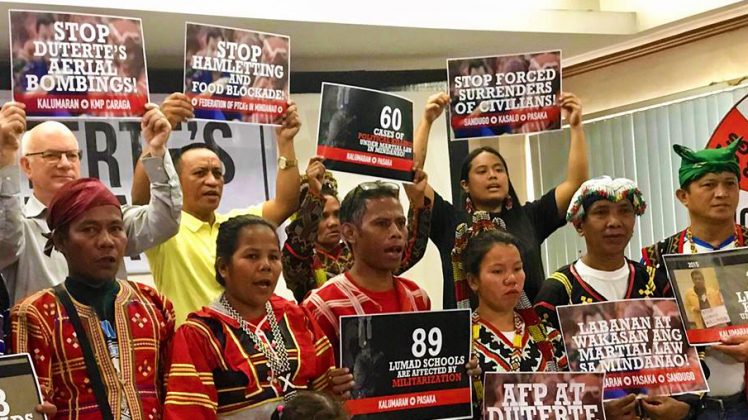Luis V. Teodoro
This paper was presented at the 10th State of the Presidency (SOP) of the Center for People Empowerment in Governance (CenPEG), a pre-SONA public forum held on July 20, 2018 at the University of the Philippines’ College of Mass Communication auditorium, Diliman, Quezon City. Dean Teodoro is a member of CenPEG Board.
My assignment is the current state of the media two years after the 2016 election of Rodrigo Duterte to the Presidency, to address which would require a look into both their news and entertainment functions. However, it is their role in providing information that should most concern us, and I have therefore focused on that media responsibility.
Let me begin by recalling certain fundamentals about journalism and the press, of which the old media of print and broadcasting, and the new media via the Internet, are the current means of transmission and dissemination.
What precisely are they for, what their reason for being? Why has every regime made it its business to take them to task, to control them or even arrest and kill practitioners? Marcos had journalists arrested and shut down newspapers and broadcast networks. Mrs. Aquino sued a columnist for libel and imposed a dress code for journalists while in her presence. Fidel Ramos would berate journalists whom he thought had covered him unjustly. Joseph Estrada sued a newspaper for P100 million and launched an advertising boycott against another. Gloria Macapagal Arroyo’s husband sued 46 journalists for libel. Benigno Aquino III berated the press for inaccuracy and for focusing on his love life. But Duterte’s expressions of antipathy to media are arguably the worst since Marcos’.
The conventional answer is that journalism and the press provide information and help shape public opinion about the events and issues that in particular times and places are of common concern. But because like religion, the arts, and the sciences, journalism is also one of those human enterprises engaged in explaining to us ourselves, society, nature and the world, it also has the power to either help advance change if the information it provides is accurate, fair, relevant and complete, or to retard and prevent it if its reports are false, biased for certain interests, irrelevant or just plain incompetent.
Change as we all know is publicly accepted in this country as an urgent imperative even by those opposed to it. The Duterte regime came to power in 2016 on the wave of the demand for change and even revolution by promising that change is coming–a promise which, if we look back to past election campaigns, wasn’t really new. Even Marcos promised to “make this nation great again” in 1965, and to “save the Republic and reform society” when he declared martial law in 1972. It’s clear enough why everyone says they’re for change: 21.9 million Filipinos are officially considered poor, notes the National Anti-Poverty Commission’s 2017 report, ReformingPhilippine Anti–Poverty Policy, but some 50 to 60 million more are vulnerable enough for the quality of their lives and those of their families to be at risk when catastrophes such as illness, the loss of a job, or– in the time of Tokhang, the Tambay campaign and TRAIN–the death of a breadwinner or of a son or a daughter, or inflation, befall them.
Among the consequences of this true state of the nation are social unrest, rebellions, insurgencies and the rise of revolutionary movements. In response, those in command of the Philippine state, while claiming to be committed to change, rather than address their causes have used varying means and devices as well as violence and force to suppress the social and political consequences of poverty. The outstanding example so far is the declaration of martial law in 1972. But a repeat of it is increasingly becoming likely in these perilous times–that is, if an undeclared, de facto version of it isn’t already here.
It should be more than evident that under these conditions, the central task of journalism is to provide the information and analysis crucial to mass understanding of the dimensions and roots of, and the possible solutions to, Philippine poverty and its attendant consequences as the necessary condition to putting in place the changes needed. But as an institution that can flourish and achieve that task under conditions of freedom not only for itself but for all, the press is also called upon to resist dictatorship and tyranny.
The bad news is that, with very rare exceptions, much of the journalism that we see through the dominant media is not doing either. Despite the verbal, physical and supposedly “legal” attacks and pressures– the ban on some reporters’ coverage of Malacanang; the cancellation of online news site Rappler’s Securities and Exchange Commission registration; the threat to cancel network franchises; the insults and hate speech directed at critical journalists not only by regime-paid trolls and its media mercenaries, but even by President Duterte himself; the pressure to take down even two four-year-old opinion pieces on inquirer.net ; and the continuing killing of journalists whose deaths have all been wrongly described as due to corruption –despite these assaults on individual practitioners, media organizations, and even the dead, and consequently the imperative to be better at describing and explaining what is happening and why, there is little sense of urgency evident in the reporting in broadcasting, print and online news sites.
For much of the corporate media it’s still business as usual. The regime drive to federalism and rush to adopt a new constitution, for example, is treated as just another news event rather than an issue that needs the most careful examination because of their impact on governance and the people’s lives and future. Corporate news media reportage still mostly consists of what is known in journalism as “he-said-she-said” reporting, in which the claims, no matter how ridiculous, of this side and that in any issue, as well as the lies of those whose agenda is to mislead media audiences with false, misleading and distorted information in order to retard change and frustrate the democratization of Philippine society, are quoted without analysis, critical discernment, or context. This kind of reporting isn’t journalism but stenography, as the Australian film maker and journalist John Pilger warns, journalism’s task being, in the words of Bob Woodward who, together with Carl Bernstein, exposed the conspiracy behind the Watergate break-in that led to the resignation of then US President Richard Nixon, “getting the full story and the meaning of that story.”
Among the powers of the media is their capacity to endow status and legitimacy. By quoting them without analysis or discernment even when they don’t have anything accurate or of any value to contribute to public understanding of events and issues, the press also transforms liars, PR hacks, clueless bureaucrats and scoundrels into “political analysts” and statesmen. As a consequence, their views no matter how biased are regarded as meaningful and based on sound information by the uncritical media audience. The result is the continuing debasement of public discourse.
Meanwhile, the absence of context, which is necessary to enable the media audience to gain any reasonable understanding of issues and events, remains a common and dangerous failing in the Philippine press.
A case in point is the reporting on the Marawi crisis. The reporting by the major tv networks was overwhelmingly–about 95 percent– on the fighting, a study by the Center for Media Freedom and Responsibility found. When asked why he and his media organization were focused on the fighting to the neglect of other issues, one of the reporters of a major tv network said that that was what the tv audience wanted.
The claim that they’re merely providing the public what it wants is a long standing excuse both here as in the United States, with which country we share the same media model as commercial enterprises under private ownership. The reality is that what the public wants is what the media have made it to want and which they reinforce from day to day. The media assume that the public prefers trivia and entertainment even in the news and that it is not interested in such equally newsworthy stories as the discrimination residents of Marawi who had fled to other cities in Mindanao suffered when they were either refused as tenants in housing and apartment units, or charged exorbitant rental fees.
Of equal interest is the fact that in violation of the professional and ethical standards of multi-sourcing, the journalists covering Marawi, in a pattern common in conflict reporting, used government sources–the military, the police, government officials including Defense Secretary Delfin Lorenzana and President Duterte–exclusively despite the availability of NGO and local Maranao community leaders. Neither did the press ask such crucial questions as why the city was bombed into rubble.
For that matter, has any journalist in the corporate media ever explained what the peace talks were all about, what the NDFP wants, what the contents of its 12-point program are, or that of the Comprehensive Agreement on Social and Economic Reforms of which the signing by both peace panels could have led to the cessation of hostilities between the NDFP and the Philippine government?
Journalists must ask a variety of sources the right questions not only to get the facts but also to provide their print, broadcast or online audiences the meaning of events. Freedom of the press is not just about the right to air, say or print anything according to one’s best lights and conscience; it includes as well the duty of creating an informed and engaged audience, which is specially crucial in times of peril such as the present.
In Year Two of the Duterte regime, some journalists and media organizations did try their best to be as truthful, as accurate, and as critical as the ethical and professional standards of journalism demand. Coalitions have also been formed by individual journalists and some press organizations to defend press and everyone else’s freedom. Fact checking their own reports and the claims of news sources has been emphasized as urgently necessary as a means of combatting the campaign to vilify the press and undermine its credibility. But the efforts to unite journalists for the defense of freedom have foundered on the shoals of the divisions that have always been the fundamental weakness of a press and media controlled by conflicting political and economic interests. As a result the exceptions to the kind of reporting that provides some of the facts but not their meaning, or which even fail to provide the details of an event or contentious issue, are so rare they stand out like oases in a desert of silent acquiescence, because truth-telling, accuracy and critical analysis are almost certain guarantees that the practitioner will be banned from coverage, insulted, threatened by online trolls and even disparaged by those who call themselves journalists but who, out of self-interest make it their business to defend the regime and assail its critics.
The Philippine corporate media are for the most part not asking the right questions at a time when it is most urgent to find the answers to stopping the killings, the human rights violations, the violence and the threat–or reality– of the return of authoritarian rule. Rather than helping enlighten their audiences, they’re instead contributing to the further confusion and misinformation of the public in, ironically, the so-called information age in which billions of bytes of information flood the planet daily.
Thankfully, the alternative media tradition that goes back to the reform and revolutionary periods of Philippine history–which provided the information needed to understand and overthrow the Spanish colonial regime; which argued for immediate independence during the US colonial period; which fought Japanese propaganda during World War II; and which exposed the lies, crimes and deceit of the Marcos terror regime–that tradition is alive and well in over a hundred video groups, newspapers, radio stations and online news sites scattered all over the country. Among these are Bulatlat, Kodao Productions, Manila Today, AlterMidya, Kilab, Davao Today, Alab News, Southern Dispatch, Pinoy Weekly, Tudla Productions, Arkibong Bayan.
True to the alternative tradition–which is the mainstream tradition in the Philippine press and media because it is the tradition that during the worst stages of the Philippine crisis provided the information and analysis–these and their sister and brother media organizations and their dedicated and courageous journalists are chronicling and explaining what is happening today, when the country and the Filipino people are once again in the gravest danger since the months and weeks prior to September 21,1972. They cover some of the most dangerous beats in these isles of fear: Mindanao under martial law; the military occupied Lumad communities; the localities where the culture of impunity is strongest and violence the rule of life, and human rights violations and the killing of journalists are continuing. They deploy journalists with fact finding missions in conflict areas; they provide backgrounders, sidebars and histories to put events in context; they fight corruption and local tyranny; and they are committed to reporting and explaining events and issues in furtherance of the need for change, often at great risk to their lives. The alternative media are this country’s one true hope in the achievement of the dangerous and difficult task of enlightening the citizenry, quite simply because the corporate media, despite the presence in them of well-meaning professionals earnestly committed to truth-telling, are not about change but about keeping things the way they are and have always been. Posted by CenPEG





Leave a Reply